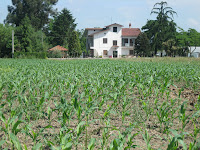
I have read on the italian rural network "Bionieri" that september 25th is the Earth Overshoot Day: it is the day when humanity begins living beyond its ecological means. Beyond that day, we move into the ecological equivalent of deficit spending, utilizing resources at a rate faster than what the planet can regenerate in a calendar year.
All this is happening just while the Pittsburg G20 Summit is starting its activities...
More info:
Global Footprint Network _____________________________________________
What is Earth Overshoot Day?
Earth Overshoot Day marks an unfortunate milestone: the day when humanity begins living beyond its ecological means. Beyond that day, we move into the ecological equivalent of deficit spending, utilizing resources at a rate faster than what the planet can regenerate in a calendar year.
Globally, we now require the equivalent of 1.4 planets to support our lifestyles. Put another way, in less than 10 months, humanity will have used ecological services it takes 12 months for the Earth to regenerate.

Of course, we only have one Earth. The fact that we are using (or “spending” natural capital) faster than it can replenish is similar to having expenditures that continually exceed income. In planetary terms, the results of our ecological overspending are becoming more clear by the day. Climate change – a result of carbon being emitted faster than it can be reabsorbed by the forests and seas – is the most obvious and arguably pressing result. But there are others as well: shrinking forests, species loss, fisheries collapse and freshwater stress to name a few.
What is Overshoot?
Just like any company, nature has a budget -- it can only produce so many resources and absorb so much waste every year. The problem is, our demand for nature's services is exceeding what it can provide.
In 2009, humanity is projected to use about 40 percent more than nature can regenerate this year. This problem -- using resources faster than they can regenerate and creating waste such as CO2 faster than it can be absorbed -- is called ecological overshoot.
We currently maintain this overshoot by liquidating the planet’s natural resources. For example we can cut trees faster than they re-grow, and catch fish at a rate faster than they repopulate. While this can be done for a short while, overshoot ultimately leads to the depletion of resources on which our economy depends.

Humanity first went into overshoot in 1986; before that time the global community consumed resources and produced carbon dioxide at a rate consistent with what the planet could produce and reabsorb. By 1996, however, humanity was using 15 percent more resources in a year than the planet could supply, with Earth Overshoot Day falling in November. This year, more than two decades since we first went into overshoot, because we are now demanding resources at a rate of 40 percent faster than the planet can produce them.
In 2008, Earth Overshoot Day was reached on September 23.
How is Earth Overshoot Day Calculated?
[ world biocapacity / world Ecological Footprint ] x 365 = Earth Overshoot Day Day
Put simply, Earth Overshoot Day shows the day on which our total Ecological Footprint (measured in global hectares) is equal to the biocapacity (also measured in global hectares) that nature can regenerate in that year. For the rest of the year, we are accumulating debt by depleting our natural capital and letting waste accumulate.
The day of the year on which humanity enters into overshoot and begins adding to our ecological debt is calculated by calculating the ratio of global available biocapacity to global Ecological Footprint and multiplying by 365. From this, we find the number of days of demand that the biosphere could supply, and the number of days we operate in overshoot.
This ratio shows that in 2009, in just 268 days, we demanded the biosphere’s entire capacity for the year. The 267th day of the year is September 25.
If you have further questions about the Ecological Footprint and overshoot calculations, there are a number of resources available through our website to learn more: See the Living Planet Report and the Earth Overshoot Day Media Backgrounder for definitions, data and further information about overshoot. You can also read our methodology paper for a more technical overview of our calculation methods, and visit our glossary page for definitions of terms. If you have further inquiries about Earth Overshoot Day, please contact Nicole Freeling.










